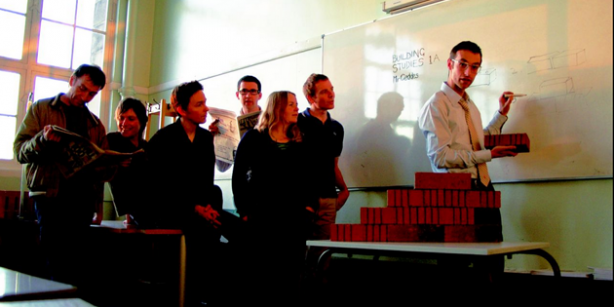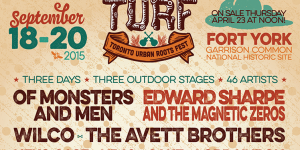 Music
Music
AUX does TURF: 9 questions about Toronto's first outdoor roots fest
by Mark Teo
July 4, 2013
Toronto has no shortage of summer festivals—from the scrappy island-dwelling ALL CAPS! to the behemoth NXNE—but when the Toronto Urban Roots Festival arrived, it caused a caused a stir: Yes, as a city, we have festivals for every niche musical taste, but we’re severely lacking in the roots department. It was inevitable that a folk-blues-country contender would emerge, of course, but TURF mainly surprises because of its scale: Spread across a whopping four days and three venues, it’s a fest that unveiled high-powered headliners like The Arkells, She and Him, and Dawes. Risky? Yep. But TURF undeniably has the potential to become a major summer-festival player in Toronto. Still, being in its inaugural year, we’re not ready to crown it as a big-leaguer—yet. First, it’ll have to answer these questions.
Check out TURF’s full schedule, which runs from Thursday, July 4 to Sunday, July 7, here.
1. Can Toronto handle a roots-related fest?
Urbane country, thanks to well-respected elder statesmen in Blue Rodeo, newcomers in Cuff the Duke, and well-adored venues like the Queen St.’s Cameron House and Ossington’s The Dakota, has always been a large part of Toronto’s musical identity. But fact is, unlike Calgary, Winnipeg, or Saskatoon, we’ve never had a consistent, city-arresting roots fest, and arguably, it’s because local tastes tend to be quite diverse: the Carribbean-centred Caribana’s a summer mainstay; NXNE prides itself on loose, genre-free programming; Wavelength centres on all things emerging. In 2013, is there enough sustained interest non-club shows from acts like JD and His Flask, the Barr Brothers, Justin Townes Earle and Alejandro Escovedo?
2. Will TURF outgrow its own moniker—and does it want to?
To outsiders, TURF seems like the Ottawa Bluesfest: It’s an event that defies its namesake. It’s no mistake that indie-twee faves Belle and Sebastian (pictured) crown the fest’s poster, with the Zooey-powered She & Him, celt-punk mainstays Flogging Molly, and the ever-positive Hold Steady not far behind. There’s little cohesion—or roots influence—among those names, which tells us two things: First, the programming at TURF is ambitious, if unfocused. Secondly, they’re aiming to reach a larger audience than simple folkies. Thing is, it could backfire: It could either please broad swaths or no one at all. Which leads us to the next question:
3. Will their non-folk stars outshine the rootsy types?
Because if they do, it might be time to rethink the fest’s namesake.
4. Can TURF stick around?
Let’s assume that, as a general-interest fest, TURF succeeds. Can it do what Virgin Festival couldn’t—become Toronto’s go-to outdoor fest? There’s certainly a demand: Montreal has Osheaga, Ottawa has the Bluesfest, and Calgary has its folk fest. TURF, we’re rooting for you.
5. Will TURF help Fort York emerge as a de facto Toronto outdoor facility?
Because, despite the fact that the Replacements are playing their later this year, we forget one thing: Fort York, like Echo Beach, is a very young venue. But it has the potential to be a significant one, in a city relatively devoid of outdoor concert spaces. It adequately handled last year’s Riot Fest—which, to be fair, operated under full capacity—but it remains to be seen if the venue, and the organizers, can handle a 5,000-person, sold-out crowd. We believe they can; we don’t expect a Toronto version of the Ottawa Rockfest fiasco.
6. Will TURF eventually attract its own stars?
TURF’s biggest stars—from Neko Case, to Belle and Sebastian, to Kurt Vile—are all plying their trade on the Canadian summer-fest circuit. And they’re certainly impressive names, but can TURF eventually grow to attract its own big (and non-local) names? It’s crucial for developing festivals to carve their own niches: Quebec’s Festival D’Ete, for example, makes a point of flying in acts as diverse as Skrillex and Stevie Wonder, while Calgary’s Sled Island feasts on hand-picking their headliners.
7. Will the festival target blues dads, alt-country types, urban woodsmen, or neither?
Because, demographics-wise, roots—a broad genre, if there was one—is a term that pleases multiple generations, but don’t confuse it with a universal: Old blueshounds hardly dig, say, Father John Misty as much as Fleet Foxes fans dig modern-day B.B. King. So, in collecting a diverse group of bands—from The Highest Order to Alex Escovedo—it’s hard to see which demographic TURF is targeting, if any. It could be either universally celebrated or unilaterally reviled.
8. How will the clubs fare?
One place where TURF diverges from other blues / folk fests in its off-site programming: Namely, they’re also hosting smaller, intimate club shows throughout the duration of the fest. It’s a significant addition to the festival—sure, it’s a diversion from the sun, but with Northcote, Atom and the Volumes, and The Highest Order playing shows between the Horseshoe Tavern and Lee’s Palace, the clubs represent TURF’s best chance at introducing fest-goers to emerging acts.
9. How else will TURF differentiate itself from other Canadian festivals?
Western festivals—like Calgary Folk—have artists jam out at collaborative workshops. Rouyn-Noranda’s FME, on the other hand, is built on exposing emerging artists. Festival D’Ete prides itself on taking over Quebec City entirely. TURF’s only in its first year—and they’ve opened with a promising lineup—but, should it endure as a fest, it begs another question: How will it separate from the summer-fest pack?
Tags: Music, News, Toronto Urban Roots Festival





